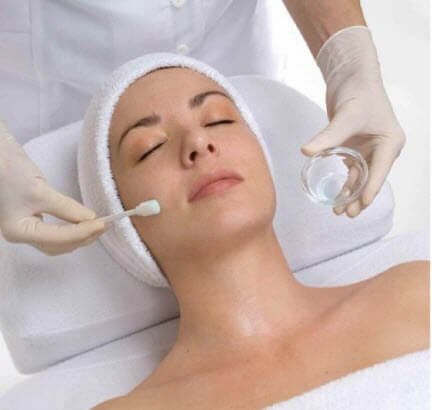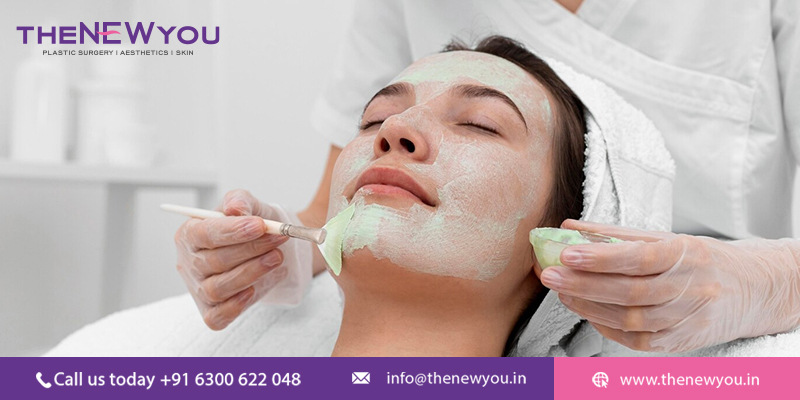Truly beautiful and attractive skin is flawless and healthy skin that glows from within. But even the most beautiful skin can be affected and shrouded by wrinkles, pigmentation, sun damage and blotchy patches and in some cases these skin issues require cosmetic treatments in order to achieve youthful and younger looking skin. Chemical peeling is one such effective and least invasive cosmetic procedure that efficiently addresses all these issues without causing any potential side-effects.
Chemical peel is a treatment in which acid solutions such as alpha hydroxy acids (AHA), trichloroacetic acid (TCA), or phenol are applied on the damaged surface layer of the skin which blisters and eventually peels off, revealing the new skin that is smoother and less wrinkled compared to the old skin. Chemical peels are also beneficial for improving the skin on the neck and hands. Chemical peels are usually performed by plastic surgeons or dermatologists. Although, chemical peels with weaker solutions are available for home use, but it is best to allow well-trained professionals to perform the procedure.
Types of Chemical Peels
There are three separate types of chemical peels for skin depending on the intensity of the peel.
Light Peels
A light peel contains mild acids like alpha hydroxy acid (AHA) and beta hydroxy acid (BHA) that penetrates the epidermis or topmost layer of the skin and exfoliates it gently in order to treat mild skin discoloration and rough skin. The peel might cause some light stinging, and the face may appear red for a few days after the peel. One can also experience some scaling for a few days. Light peels usually take seven days to heal completely. Soothing lotions and creams should be applied to the skin until it heals completely along with daily use of sunscreen. Light peels can be used for skin peeling on the face along with neck and hands.
Medium Peels
A medium chemical peel for face uses Glycolic or trichloroacetic acid that penetrates the outer and middle layers of the skin in order to get rid of the damaged skin cells. The medium peel is the ideal chemical peeling for acne, age spots, wrinkles, fine lines, freckles and moderate skin discoloration. The medium peel takes 7 to 14 days to recover completely. The treated skin may appear swollen and red for the first 48 hours along with blisters that will crust and peel off within 7 to 14 days.

Deep Peel
The deep peel procedure uses Tricholoracetic acid or phenol that penetrates into the deeper layers of the dermis and helps to remove age spots, freckles, moderate lines, shallow scars, and freckles. Deep peel provides dramatic improvements in the appearance of the skin, but this procedure can be used only on the face and can be performed only once. The treated area requires 14 to 21 days to heal completely. The treated skin is bandaged, and the skin is soaked 4 to 6 times daily followed by application of ointment for the first 14 days and a thick moisturizer for the next 14 days. Mild lotions and creams can be applied, and antiviral medication should be taken for 10 to 14 days. Deep peel cause redness, swelling, pain and discomfort for few days so you might receive painkillers. Sun exposure must be avoided for 6 months. Several follow-up appointments are required to monitor the progress.
Step by Step Procedure of Chemical Skin Peel
While some aspects of the chemical peel differ as per the type of the peel that is being used, but there as some basic steps involved in the procedure that remains the same.
- A chemical peel is administered in the doctor’s chamber or surgery center, and it should be performed only by a certified and trained dermatologist or plastic surgeon.
- The doctor determines the skin type and major skin issues and administers a chemical peel accordingly. If it is a deep chemical peel, then the patient might be given a sedative to promote relaxation.
- The doctor will cleanse the skin of the patient and apply a topical anesthetic to the area that is to be treated.
- Next, the doctor will apply the chemical peel solution that is formulated for the specific needs of each patient.
- The patient might feel a tingling or stinging sensation while the peel is applied.
- After application of the peel solution, it is allowed to sit for the prescribed amount of time and then washed off with water.
- A soothing ointment or thick coating of petroleum jelly is then applied on the skin.
- The doctor provides instructions about aftercare along with medicines and mild pain relievers to reduce the discomfort.
- Based on the depth of the chemical peel, several treatments might be required to get the desired results.
Consult an experienced cosmetic surgeon or dermatologist about chemical peels and which one is most suitable for your skin issues before you decide to opt for the procedure.










